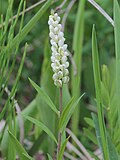Note: This is a project under development. The articles on this wiki are just being initiated and broadly incomplete. You can Help creating new pages.
Difference between revisions of "Polygala senega - Senegaroot"
| Line 4: | Line 4: | ||
==Uses== | ==Uses== | ||
| − | {{Uses|Asthma}}, {{Uses| | + | {{Uses|Asthma}}, {{Uses|Chronic bronchitis}}, {{Uses|Snakebites}}, {{Uses|Emphysema}}, {{Uses|Rattlesnake bite}}, {{Uses|Phlegm}}, {{Uses|Pimples}}, {{Uses|Diarrhea}}, {{Uses|Sore throats}} |
==Parts Used== | ==Parts Used== | ||
| − | {{Parts Used|Dried | + | {{Parts Used|Dried root}}. |
==Chemical Composition== | ==Chemical Composition== | ||
Seneca snakeroot contains a series of saponins constructed from the 2,3,27-trihydroxy-oleanane 23,28-dioic acid triterpene skeleton (presenegenin)<ref name="chemical composition"/> | Seneca snakeroot contains a series of saponins constructed from the 2,3,27-trihydroxy-oleanane 23,28-dioic acid triterpene skeleton (presenegenin)<ref name="chemical composition"/> | ||
==Common names== | ==Common names== | ||
| − | {{Common names|kn=|ml=|sa=|ta= | + | {{Common names|kn=|ml=|sa=|ta=Cenakanankai|te=|hi=|en=Milkwort, Rattlesnake root}} |
==Properties== | ==Properties== | ||
| Line 61: | Line 61: | ||
<gallery class="left" caption="" widths="140px" heights="140px"> | <gallery class="left" caption="" widths="140px" heights="140px"> | ||
Polygala senega 2.jpg | Polygala senega 2.jpg | ||
| − | |||
| − | |||
Polygala senega NY-dist-map.png | Polygala senega NY-dist-map.png | ||
| − | |||
| − | |||
Polygala senega usgs.jpg | Polygala senega usgs.jpg | ||
| − | |||
| − | |||
Polygala senega.jpg | Polygala senega.jpg | ||
| − | |||
</gallery> | </gallery> | ||
==References== | ==References== | ||
| − | |||
<references> | <references> | ||
<ref name="chemical composition">[https://www.drugs.com/npp/senega-root.html "Chemistry"]</ref> | <ref name="chemical composition">[https://www.drugs.com/npp/senega-root.html "Chemistry"]</ref> | ||
| − | |||
<ref name="Leaf">[https://gobotany.newenglandwild.org/species/polygala/senega/ "plant characteristics"]</ref> | <ref name="Leaf">[https://gobotany.newenglandwild.org/species/polygala/senega/ "plant characteristics"]</ref> | ||
| − | |||
<ref name="How to plant/cultivate">[https://www.pfaf.org/User/Plant.aspx?LatinName=Polygala+senega "Cultivation details"]</ref> | <ref name="How to plant/cultivate">[https://www.pfaf.org/User/Plant.aspx?LatinName=Polygala+senega "Cultivation details"]</ref> | ||
</references> | </references> | ||
Revision as of 12:01, 21 January 2019
Polygala senega is a species of flowering plant in the milkwort family, Polygalaceae. It is native to North America, where it is distributed in southern Canada and the central and eastern United States.
Contents
[hide]- 1 Uses
- 2 Parts Used
- 3 Chemical Composition
- 4 Common names
- 5 Properties
- 6 Habit
- 7 Identification
- 8 List of Ayurvedic medicine in which the herb is used
- 9 Where to get the saplings
- 10 Mode of Propagation
- 11 How to plant/cultivate
- 12 Commonly seen growing in areas
- 13 Photo Gallery
- 14 References
- 15 External Links
Uses
Asthma, Chronic bronchitis, Snakebites, Emphysema, Rattlesnake bite, Phlegm, Pimples, Diarrhea, Sore throats
Parts Used
Chemical Composition
Seneca snakeroot contains a series of saponins constructed from the 2,3,27-trihydroxy-oleanane 23,28-dioic acid triterpene skeleton (presenegenin)[1]
Common names
| Language | Common name |
|---|---|
| Kannada | |
| Hindi | |
| Malayalam | |
| Tamil | Cenakanankai |
| Telugu | |
| Marathi | NA |
| Gujarathi | NA |
| Punjabi | NA |
| Kashmiri | NA |
| Sanskrit | |
| English | Milkwort, Rattlesnake root |
Properties
Reference: Dravya - Substance, Rasa - Taste, Guna - Qualities, Veerya - Potency, Vipaka - Post-digesion effect, Karma - Pharmacological activity, Prabhava - Therepeutics.
Dravya
Rasa
Tikta (Bitter), Kashaya (Astringent)
Guna
Laghu (Light), Ruksha (Dry), Tikshna (Sharp)
Veerya
Ushna (Hot)
Vipaka
Katu (Pungent)
Karma
Kapha, Vata
Prabhava
Habit
Identification
Leaf
| Kind | Shape | Feature |
|---|---|---|
| Simple | Alternate | The leaves are simple i.e lobed or unlobed but not separated into leaflets |
Flower
| Type | Size | Color and composition | Stamen | More information |
|---|---|---|---|---|
| Unisexual | 2-4cm long | white | 8 | Flowers Season is June - August and the flower is bilaterally symmetrical |
Fruit
| Type | Size | Mass | Appearance | Seeds | More information |
|---|---|---|---|---|---|
| General | 3–3.5 mm | the fruit is dry and splits open when ripe | many | {{{6}}} |
Other features
List of Ayurvedic medicine in which the herb is used
- Vishatinduka Taila as root juice extract
Where to get the saplings
Mode of Propagation
How to plant/cultivate
Prefers a moderately fertile moisture-retentive well-drained soil, succeeding in full sun if the soil remains moist throughout the growing season[3]
Commonly seen growing in areas
Tall grasslands, Borders of forests and fields.
Photo Gallery
References
External Links
- Ayurvedic Herbs known to be helpful to treat Asthma
- Ayurvedic Herbs known to be helpful to treat Chronic bronchitis
- Ayurvedic Herbs known to be helpful to treat Snakebites
- Ayurvedic Herbs known to be helpful to treat Emphysema
- Ayurvedic Herbs known to be helpful to treat Rattlesnake bite
- Ayurvedic Herbs known to be helpful to treat Phlegm
- Ayurvedic Herbs known to be helpful to treat Pimples
- Ayurvedic Herbs known to be helpful to treat Diarrhea
- Ayurvedic Herbs known to be helpful to treat Sore throats
- Herbs with Dried root used in medicine
- Herbs with common name in Tamil
- Herbs with common name in English
- Habit - Herb
- Index of Plants which can be propagated by Seeds
- Herbs that are commonly seen in the region of Tall grasslands
- Herbs that are commonly seen in the region of Borders of forests and fields
- Herbs




